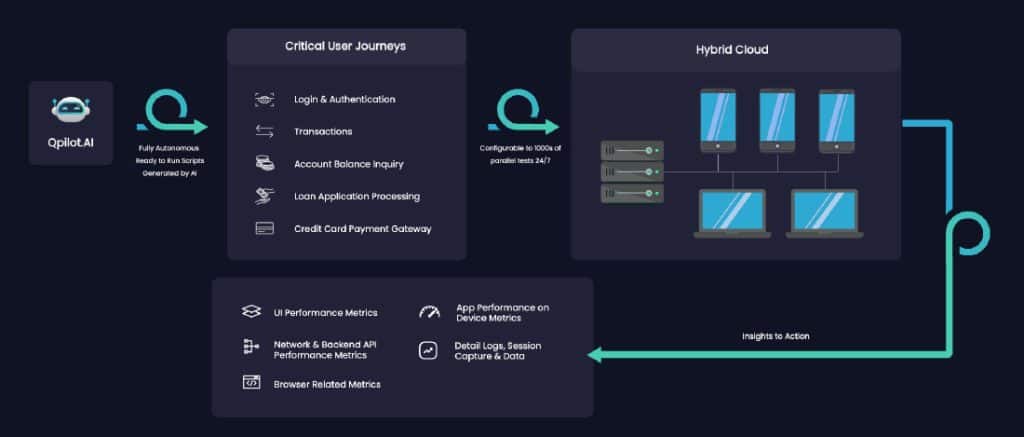Synthetic monitoring is the practice of using automated scripts to simulate real user interactions continuously and to test the key application functionalities and performance. The scripts mainly focus on the typical user’s journey and help them manage situations like account logins, money transfers, bill payments, and mobile check deposits, which not only eliminate errors but also replace smooth operations as well.
In the digital banking sector, synthetic monitoring is an early warning system that functions as your protector. He is the quality inspector in the universe of banking users; he keeps on checking that each step of customer interaction is authentic.
For instance, this system may periodically introduce the login transaction to ensure its optimal performance, thereby preventing latency or failure issues that could upset customers. It can also validate complicated workflows like international fund transfers, which in turn will clear out the bottlenecks before they affect the genuine users.
Digital Experience Testing Platforms like Pcloudy’s AI-powered unified testing suite for BFSI provide the banking sector with the capacity for app functional validation across numerous operating systems, screen sizes, and network conditions using real devices.
A complete and deeper understanding of application performance, such as UI performance, API response times, and device-level analytics, can help detect bottlenecks and ultimately avoid service outages.
Meaningful logs and capturing sessions could help speed up troubleshooting to detect and resolve problems before they cause any kind of impact. This also reduces the risks associated with new feature releases and infrastructure changes, hence promoting customer satisfaction and the brand’s positive image.
Best Practices for Implementing Synthetic Monitoring in Banking
1. Defining Key User Journeys
The first step in effective synthetic monitoring is to identify mission-critical digital interactions that customers rely on. For banks, these typically include:
- Login authentication and multi-factor verification
- Account balance inquiries and transaction history retrieval
- Fund transfers, bill payments, and loan application processing
- Integration with third-party financial services and APIs
By defining these critical workflows, banks can ensure that synthetic tests focus on the areas that directly impact customer experience and business operations.
2. Automating and Scaling Synthetic Monitoring with AI
Traditional synthetic monitoring relies on pre-scripted automation, which requires significant effort to create and maintain. AI-driven synthetic monitoring tools, such as Pcloudy’s Qpilot.AI, simplify this process by:
- Enabling test script creation using natural language inputs
- Automatically generating and executing synthetic test cases
- Applying validations and assertions dynamically to ensure accuracy
- Allowing test data parameterization for realistic simulations
With AI-powered automation, banks can scale their monitoring efforts without the need for extensive scripting, reducing maintenance overhead while improving test coverage.
3. Ensuring Cross-Platform and Cross-Device Testing
Customers interact with banking applications across a wide range of devices and network conditions. To ensure consistent performance, synthetic monitoring should be conducted across:
- Various mobile and desktop operating systems (iOS, Android, Windows, macOS)
- Different screen sizes and device configurations
- Multiple geographic locations to detect region-specific performance issues
- Network variations (WiFi, 4G, 5G) to simulate real-world conditions
For example, synthetic tests running on Pcloudy’s cloud-based real device lab allow QA teams to validate application behavior under different conditions, ensuring that regional network differences or device-specific issues do not affect the user experience.
4. Integrating Synthetic Monitoring into CI/CD Pipelines
To maximize efficiency, synthetic monitoring should be embedded directly into CI/CD workflows. By integrating synthetic tests into the software development lifecycle, banks can:
- Detect performance regressions before deployment
- Identify anomalies early and trigger real-time alerts
- Reduce downtime and prevent unexpected failures
AI-driven monitoring solutions, such as Qpilot.AI, enable automated detection of anomalies and performance deviations, ensuring that banks can proactively resolve issues before they impact customers.

Limitations and Complementary Monitoring Strategies
Synthetic monitoring offers extensive value but has certain limitations as well. The nature of synthetic monitoring also results from the failure to capture actual real-time user behaviors and unexpected usage patterns. It sometimes fails to be beneficial as it is mostly based on simulated interaction rather than actual use. Thus, alone, it will not be able to deal with the complexities that may arise from third-party integrations or the internal technical problems with the backend systems.
To counter those defects, digital banks must integrate synthetic monitoring with Real User Monitoring (RUM). RUM is another data source that reveals more profound insights into how an application performs in the wild and what the user experience is by collecting data from actual user interactions.
If banks want a complete solution, they must integrate synthetic and real-user monitoring to ensure both performance and customer satisfaction are optimal.

Approach for Implementing Synthetic Monitoring

1. Define Monitoring Goals: Completely determine important user journeys and the high-risk transactions that are critical for constant monitoring.
2. Develop Comprehensive Test Scripts: Plan precisely and easily script the real-world usage scenarios that can copy user interaction, giving a 360-degree view of the user experience.
3. Select Strategic Monitoring Locations: The monitoring should be deployed across all key locations from where customers will be able to access digital banking services.
4. Integrate with Development Lifecycle: Start synthetic monitoring for the software early in the development cycle and make it ready by the time your application is ready to go live.
5. Continuous Improvement: Efficiency can be improved by frequently analyzing data already collected, optimizing the tests, and increasing the scope of monitoring.
Conclusion
Synthetic monitoring has become critical as 3 out of 4 banking customers depend on digital means for banking. The strategy of systematically managing applications via synthetic monitoring has a direct influence on the level of satisfaction, loyalty, and trust of our customers.
Platforms like Pcloudy have adaptive AI-driven test scripts that can be applied in real-time and in various regions. By choosing synthetic monitoring as the basic enabler of your testing strategy, you can ensure the uninterrupted functioning of your day-to-day operations and gain long-lasting success in the digital banking sector.






